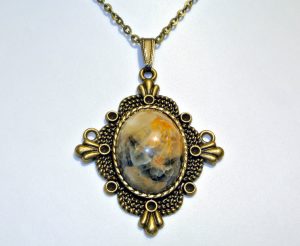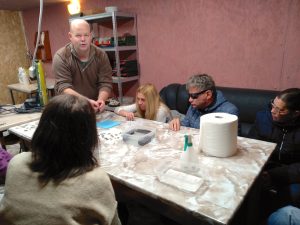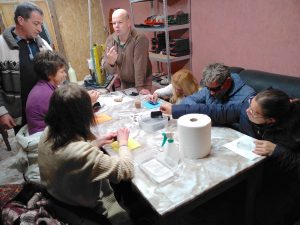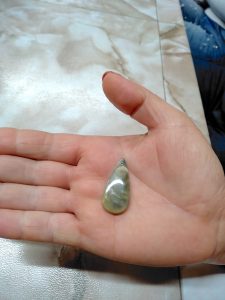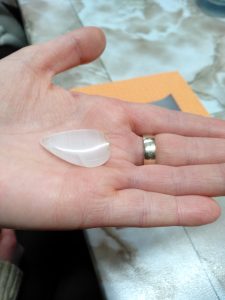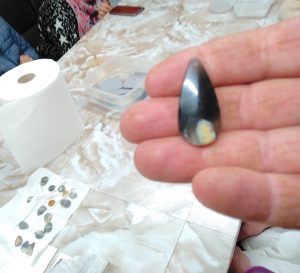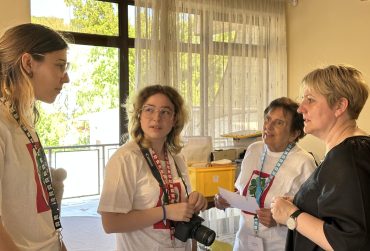We became part of a very beautiful, noble, courageous, creative and respectable story. Mr. Zoltán Pál, one of the operators and owners of the Aragonite Museum in Korond, contacted us with an offer to polish the semi-precious stone by the visually impaired. “How beautiful it would be,” he said, “if the glow of the Szekler diamond were given by the blind.” During the last three grinding phases, the changes on the surface of the aragonite are not perceptible to the naked eye, only with a very fine touch and after the last phase of work does the aragonite begin to share its light. The finished semi-precious stone is not treated or polished with any other material after machining, the light of translucent, opaque, sometimes deep-toned colours are all natural.
We forwarded Mr. Pál’s offer to a couple of adult visually impaired people and then we visited the grinding workshop in Korond together at a convenient time. Warm tea and coffee awaited us, shaped and unpolished semi-precious stones, and a very enthusiastic, modest and prepared performer – Mr. Pál himself. “The stone lives,” it was said, and the statement is really true, because for decades, or even centuries, special quality spring waters saturated with minerals (he said, spring water contains so much dissolved mineral that after seven liters of evaporated water one kilogram of solid remains), the crystal layers deposited slowly contain in many cases organic substances (such as bacteria), which also give the aragonite a discoloration and an unrepeatable pattern. Our visually impaired friends could easily determine which stone had undergone which grinding or polishing phase. We have experienced that if even a few minutes of operation is missed, the Sekler diamond will not shine. Every little detail of the manual work that has been experimented over decades has to be done on aragonite to finally share its shine with us. The rarity of the stone, the uniqueness of its colours and patterns, the time spent and the special quality of the handicraft work gives the value of the Korondian aragonite, referred to as the Sekler diamond.
This is how a noble and beautiful cooperation was established between the micro-enterprise of traditional semi-precious stone producing in Korond and the Hungarian blind and visually impaired.
A brief historical review
At the invitation of the Hungarian government, geologist and craftsman Vencel Knop, a Czech engineer, settled in Zalatna in 1895 and took over the management of the stone carving and polishing department of the Zalatna Institute of Artists and Masters. He learns Hungarian and Romanian in one year. With the funding of the Hungarian Ministry of Commerce, he conducts geological research in Transylvania and Banat, thus meeting the Korondian aragonite. He asks for his retirement at the age of 35 and moved to Korond. In 1914, he leased three Aragonite-rich land from the village of Korond on a state loan and established the first Aragonite extraction and grinding factory in Transylvania. Innovative design, hard work and an excellent merchant attitude will bear fruit, and aragonite rock-cut, shaped and polished ornaments will reach many countries around the world. The “Sekler diamond” will be popular and famous, with ruling and noble families, bankers, citizens competing for orders.
Vencel Knop dies in 1941, and his wife continues to run the business, which was going well by then. The factory was nationalized in 1949 and became the property of the Székelyudvarhely cooperative. For faster extraction and mass production, aragonite, which had previously been mined with careful human power, is being mined with dynamite. As a result, the mine collapses very quickly, the rock cracks in the ground, production stops. After 50 years, the descendants reclaim the forcibly nationalized, already vacant and neglected former factory building and set up a museum in Korond called the Aragonite Museum.
About the aragonite
Aragonite carbonate is a mineral modification of calcite or limestone. Its formation requires the presence of carbonated salty springs – hence also called spring stones – which, when passed through calcareous rocks, are also enriched with calcium carbonate and precipitate from the saline solution in the form of layered or fine needle-shaped crystals. Due to its consistency, the semi-precious stone can be sanded well. Its color scale is determined by the oxides and sulfides of iron, the presence of sulfur, and various clay minerals. It got its name from the Aragon River in Spain, where it was discovered in 1788. Aragonite is located on three hills on the border of Korond, which is formed by filling the cracks of the earth’s crust with carbonate mineral due to the unique composition of the special quality springs.


